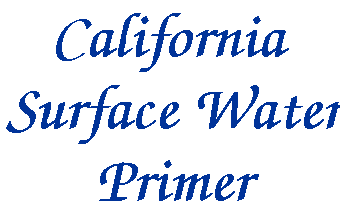![]()

Compiled by
Marcia H. Armstrongx
![]()
Preface
(Primary resource used was The California Law of Water Rights, by Wells A. Hutchins; Harvey O. Banks, State Engineer of California; in cooperation with the U.S.D.A.; Sacramento, Calif.; 1956.)
Although California water law is extremely complex, it offers an excellent illustration of the enduring relevancy of the Roman and English conventions regarding property that have become vested as doctrine in the foundations of American and California resource Law.
All water rights are "usufructuary"; that is, the right pertains to the use of the water, (including the benefits derived from its momentum or impetus,) and not to ownership of the "corpus" or body of the water itself. All water use rights are subject to conditions of "reasonable and beneficial use."
California, on April 13, 1850, adopted the common law of England so far as not repugnant to or inconsistent with the Constitution of the United States or laws of the State; (Ca. Stats. pg. 219.) This included the English doctrine of riparian rights, which became the foundation for California water use rights.